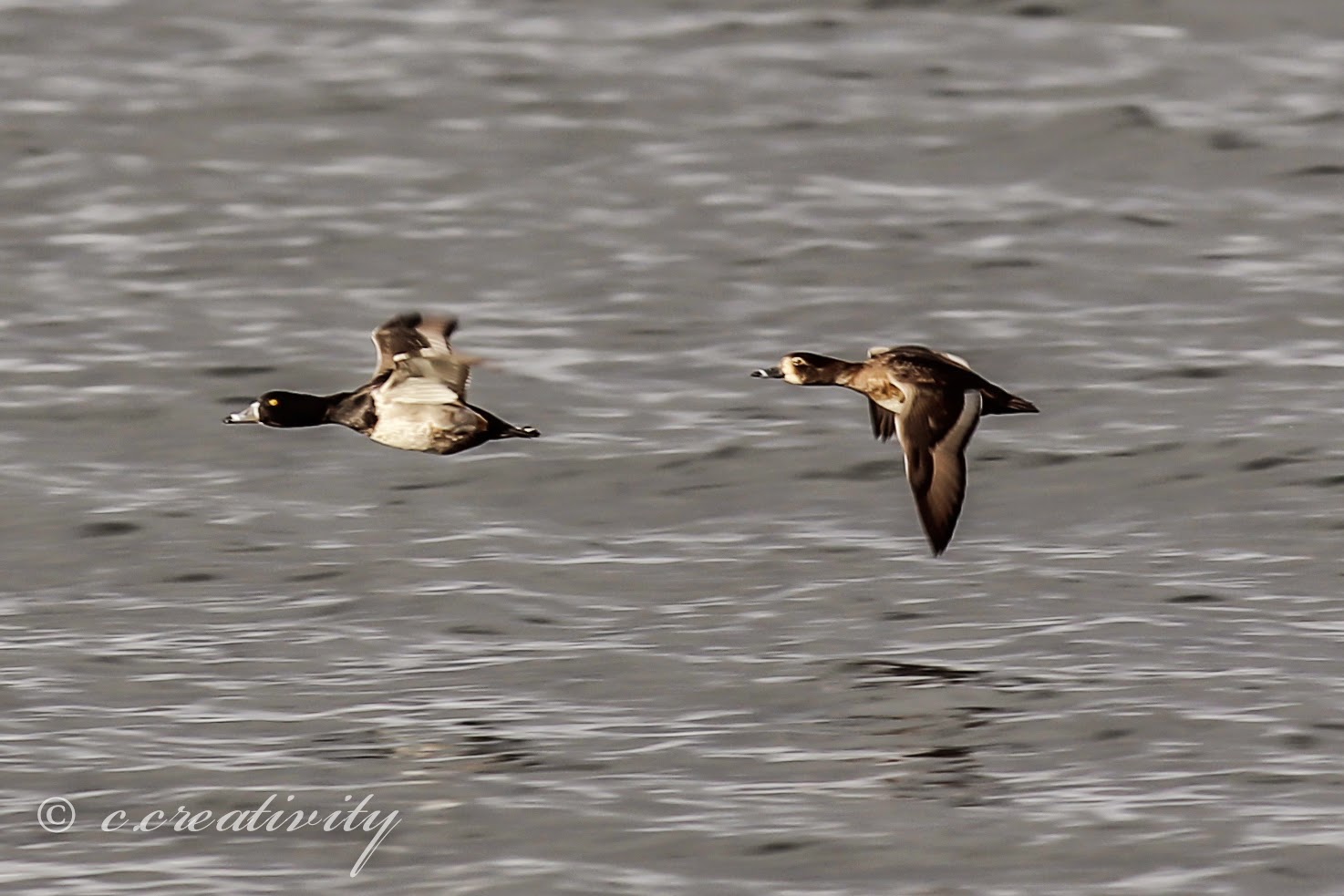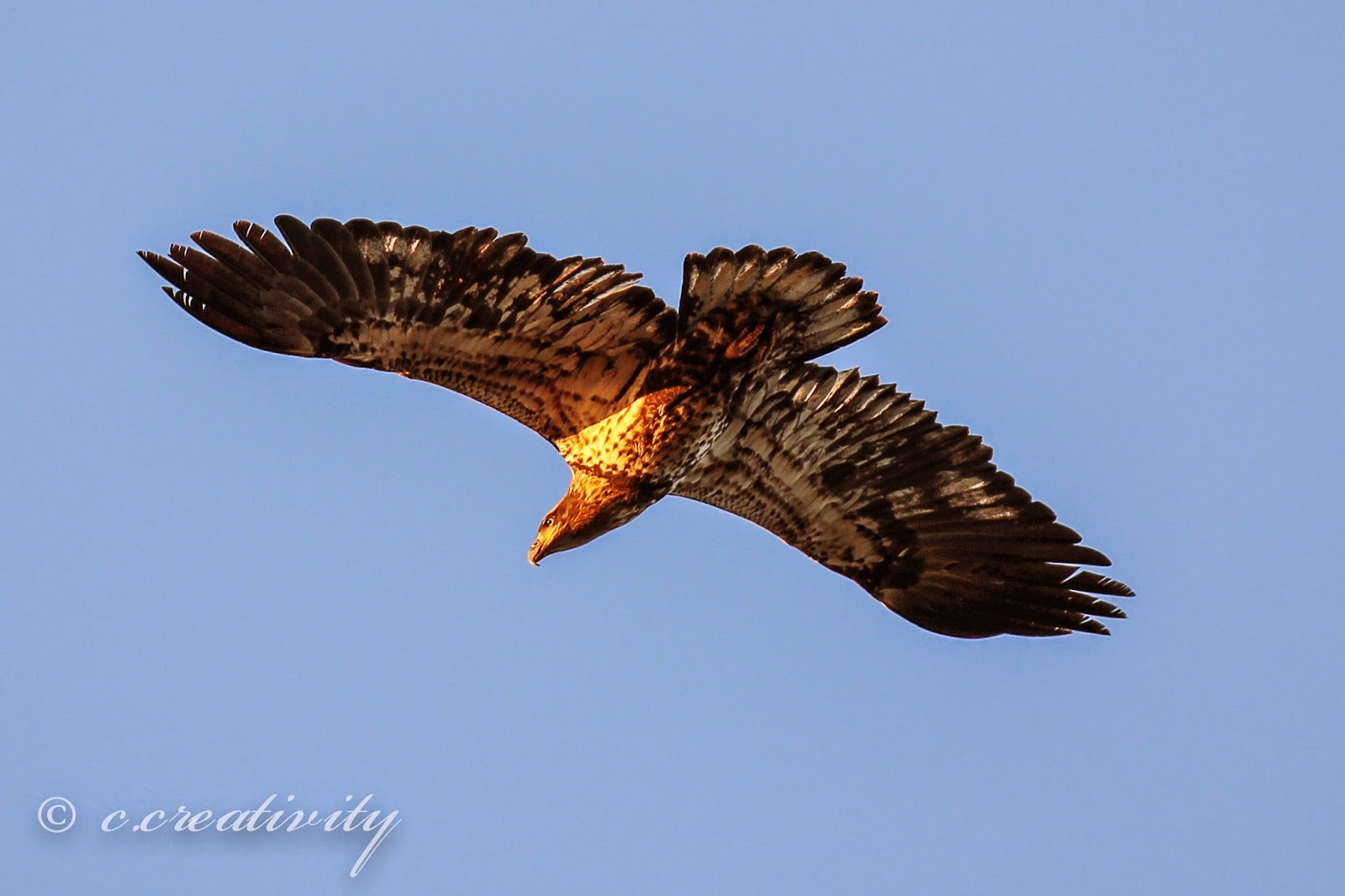 |
| An immature bald eagle (top, left of center, difficult to see against the trees unless you click on this photo to enlarge it) harasses a flock of coots, dive-bombing them seemingly for fun. |
Last month I wrote a blogpost called "33 Birds: November Edition" that listed, with photographs, all the different bird species I saw while taking care of Goldie during two weeks in November. Well, I went back to Goldie's house for ten days in December and saw nine more bird species! I thought it appropriate to create this addendum with photos of the additional birds, creating an even more comprehensive picture of the birdlife that can be found on the shores of a lake in the wilder suburbs of the Pacific Northwest in early winter. Remember, you can click on photos to enlarge them!
 |
| One of my canine ornithological assistants. Sable shares my interest in waterfowl, but for rather different reasons. |
Western Grebe
Just like the last post, since I am listing the birds in the order they appear in Golden's "Birds of North America," I have to start off with the worst photos of the bunch. I was standing on the dock one day when I saw a pair of birds with long white necks swimming at least halfway across the lake. I immediately suspected they were Western grebes because of their size and those necks and so I waited and waited and waited in hopes that they would swim my way, but they were apparently content to mosey around mid-lake, occasionally diving. These photos were therefore taken for identification purposes, for which they suffice. They certainly aren't going to win any prizes, though! I saw the grebes on one other occasion. They were on my side of the lake, but only just. They clearly like to do their fishing in far deeper water than the pied-billed grebes and others that I've seen closer to shore.
 |
| This grebe was a little bit closer, but not much. You can see the redness of its eye, though! |
 |
| It took a pause from fishing in the deep water near the center of the lake to preen. |
Ring-Necked Duck
Some days there are just oodles of birds around and the 22nd of December was one of them. I saw coots, gadwalls, buffleheads, mallards, cormorants, a male common merganser (I see females far oftener than I see males), and mixed in with all of those, a couple of unfamiliar ducks. The weather was overcast with a lot of glare and the birds were gathered to the south of my dock, so they were backlit and especially hard to see. It was not until I got the images on my computer and removed the shadows that I was able to see the details necessary to identify this particular bird as a male ring-necked duck.
 |
| A male ring-necked duck (center, top) has white stripes on its bill. |
 |
| It floats here among coots, gadwalls, and buffleheads. |
Lesser Scaup
The other new-to-me duck first seen on the day when so many waterfowl were out and about by the dock is the lesser scaup. Like the ring-necked duck, it belongs to a category of ducks called "bay ducks." These ducks are capable of diving and swimming underwater and eat both plant and animal life. There is also a greater scaup, which is larger, has a greenish vs. purplish head, and is more often seen on salt water.
 |
| A male lesser scaup has a golden eye, a dark head and chest with purplish iridescence, white sides and back with fine black mottling, and a black rump. |
 |
| A male lesser scaup swimming with coots. |
 |
| A female lesser scaup, with a dark brown head, back and tail, brown breast, brown sides with white mottling, and a white facial patch by the bill (not visible in this photograph). |
 |
| A pair of male lesser scaups. |
Bald Eagle
I had been very surprised during my stay in November not to see any bald eagles, since there have been bald eagles living on the northern end of the lake for as long as I can remember. It seemed like Goldie's house would be prime bald eagle territory. It turns out that I was right. I believe that the reason I didn't see eagles during November was because they were congregating around salmon-spawning streams. Regardless of whether or not my theory is correct, I started seeing bald eagles on a daily basis! I mainly saw an immature bald eagles and another that is just getting its adult plumage. The only downside of seeing the eagles is that the waterfowl make themselves scarce when these giant raptors are around, and for good reason: Goldie found the remains of a wing that probably belonged to a coot or bufflehead at one point beneath the eagles' favorite tree. It's funny: when one of the bald eagles gives me a once-over from the treetops or as it flies overhead, I find myself feeling honored to have caught the notice of such a predator!
 |
| An immature bald eagle. They have dark brown plumage mottled with white. |
 |
| I felt so lucky to have this immature bald eagle fly almost directly toward me as I stood on the dock before it swooped up to land in a tree on the shore. The feet and beak are strikingly yellow! |
American Coot
During the winter, coots can be seen congregating on the water in dense flocks. I think of them as "rafts." During December, rafts of coots regularly make their way past the house, sometimes lingering in favored spots just to the north and south of the dock. When not on the move--and sometimes even then--the coots dive below the surface to bring up strands of aquatic vegetation. Since there is no point in making the effort to dive for your own piece of vegetation if you can have part of your neighbor's, scuffles break out as all the surrounding coots try to snag a mouthful. I found that the coots were surprisingly difficult to photograph, a result of their dark plumage, the low winter light, and constant movement. In an effort to get decent shots, I now have way more coot photos than any sane person would wish to look through!
 |
| A wintertime congregation of coots. |
 |
| Everyone wants a piece of your aquatic vegetation! |
 |
| American coots. |
Chestnut-Backed Chickadee
I expressed surprise in my previous post that I hadn't seen any chestnut-backed chickadees because Goldie's property seemed like prime chestnut-backed chickadee habitat. I was pleased, therefore, to spot a flock of them in the trees one day. As I waited for one of the chickadees to land on a branch unobscured by other vegetation with the chestnut back visible, it started to hail. I'm not going to stand around in the hail just to prove to blog readers that I saw a chestnut-backed chickadee, so you'll have to take my word for it. I saw them again on other occasions, but they move very quickly through the trees and I never had a good chance to take a decent photo.
 |
| This was the best shot I got before the weather turned uncooperative. You can see the brownish sides, if not the back. |
Hermit Thrush
Several times during my stay I saw a noticeably nondescript (that sounds funny, but a plain bird is an unusual one!) bird flitting away in the brambles, but it wasn't until my second-to-last day that this light brown bird was kind enough to sit for a while on a branch that was visible through the tangle of vines and twigs, allowing me to photograph it and confirm my suspicions that it was a hermit thrush.
 |
| Hermit thrushes are one of a group of several similar North American thrushes with spotted breasts. Trust me, you want to click on this photo: it's one of the best of the bunch! |
 |
| This hermit thrush looks like it's singing, but it was, in fact, doing what I can only describe as "gargling berries." |
Yellow-Rumped Warbler (Audubon's Race)
Yellow-rumped warblers were one of the thirty-four species of birds that I saw at Mr. Gorgeous' place in the spring, but it turns out that those bold colors are a thing for spring--the only feature I recognized was the shape of the tail! Google helped me figure out that I was indeed looking at the same species, just in a different season's plumage. The photos are poor, as a small group of them settled only briefly high in a birch tree before flying off.
 |
| It wasn't much, but the yellow throat, deeply lobed tail... |
 |
| ...and yellow sides were sufficient information for an ID. |
Golden-Crowned Sparrow
I was looking out the dining room window into the thicket favored by the finches, juncos, and song sparrows when I saw a bird rather larger than the usual suspects perched on a branch on the far side of the bank of vegetation. It wasn't until I was looking through my camera's viewfinder that I realized I was photographing a golden-crowned sparrow. I only saw it that once, so I was glad to get a decent shot of it.
 |
| The bright yellow crown bordered by bold, black stripes give this sparrow its name. |
These nine species seen during late December, added to the thirty-three I saw in mid-November, bring my total count of birds seen and/or photographed at Goldie's new place on the lake to forty-two. It has been exciting to see the variety of birdlife this piece of property has to offer. I look forward to getting to know its birds of spring and summer in 2015!
You can see the blogpost detailing the thirty-three birds of November here.
You may also enjoy my overview of thirty-four bird species in seen in April.
And don't forget to stop by my Facebook page to see the photos I post daily!
All photographs © 2014 c.creativity






I love the golden crowned sparrow!
ReplyDelete